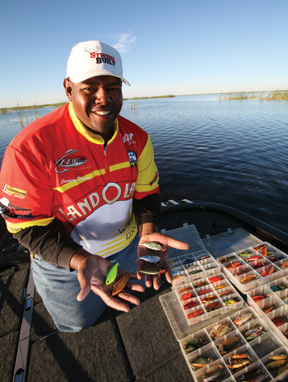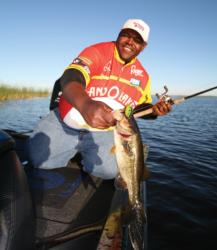Tossing ’Traps in early spring
Honing lipless crankbait skills means more bass in the boat

It’s one of those balmy, early spring days in mid-March that you wait for all year. A few daffodils are popping out, small buds can be seen on the ends of limbs and you just know it won’t be long before the first swollen-bellied sow bass are creeping up the flats to fan out their nests.
Trouble is, you’re fishing new water, and those fat sows aren’t up there quite yet. With mounds of tackle in the boat, picking something to search new water might seem like a daunting task to some anglers – but not to a bass-savvy guy like you. Anglers like you know that now is the time to be throwing a Berkley Frenzy Rattl’r, Rat-L-Trap, Rattlin’ Rapala, Cotton Cordell Spot, Lucky Craft LV-500, or most any type of rattling, lipless crankbait.
“You’ve got to fish the water you’re put in,” said Chevy pro Larry Nixon of Bee Branch, Ark. “And a lipless crankbait is as good of a search bait as there is.”
When those bass are in that key, pre-spawn window, Nixon likes to throw a lipless crankbait. He looks for fish staging around the typical spawning areas – the backs of bays and flats – and varies his retrieve and offering according to the depth of the water and then fine tunes it according to what the bass hit best.
In the 2- to 5-foot zone, Nixon will usually toss a small offering, something in the 1/4-ounce variety. He increases the size of the bait as he goes deeper, but one thing he usually stays consistent with in the spring is color.
“I like to go with a crawfish imitation of some sort in the spring,” Nixon said. “That’s what they want to be eating at that time. Brown, orange or chartreuse with an orange belly all work well for that.”
Quickly and effectively covering water and, consequently, finding bass is where the lipless crankbait really shines. Of course, once bass are located, putting the lipless-crankbait rod down and picking up something else isn’t always the best move. Lipless crankbaits are remarkably versatile lures, come in an endless variety of colors and can imitate many types of forage, sometimes making them a good bet for milking a concentration of bass once they’ve proven themselves willing to bite.
Team Land O’Lakes co-angler James Davis Jr. of Ferriday, La., who won the 2005 Wal-Mart FLW Tour event on the Ouachita River without a single day of prefishing, is a fan of lipless crankbaits for all sorts of situations but especially if he’s on a lake that is laden with vegetation. On such a lake, Davis knows the bread-and-butter of lipless crankbait presentations comes into play – ripping it out of grass.
“I’m looking for creek channels on grassy flats in a place like that,” Davis said, “and I throw the bait out there, let it sink into the grass and rip it out. Sometimes, an aggressive bass will eat it if you just reel it in quickly, but ripping it tends to work better if the area is more heavily fished.”
 Grassy flats have their differences and those differences can dictate what sort of tackle is best for ripping. “With grass like coontail, or what I call tender grass, I like to use a 7-foot, medium-heavy rod with monofilament line,” Davis said. “But when it’s heavy, tough grass, like hydrilla, I use braid. Something with no stretch will help knock that thick grass off.”
Grassy flats have their differences and those differences can dictate what sort of tackle is best for ripping. “With grass like coontail, or what I call tender grass, I like to use a 7-foot, medium-heavy rod with monofilament line,” Davis said. “But when it’s heavy, tough grass, like hydrilla, I use braid. Something with no stretch will help knock that thick grass off.”
When it comes to color choices, Davis likes to match his color choice to the dominant forage, be it crawfish, shad or bluegills.
Venturing away from vegetation, a lipless crankbait isn’t lost when it’s fished along barren banks or even for bass suspended over deep water. Take Stren Series Western Division pro Sieg Taylor of Clearlake, Calif., and his win on Clear Lake in March of 2005 for example. Taylor’s catch at that event set a record for the heaviest four-day weight (with only 16 bass, due to Clear Lake’s four-bass daily limit) in FLW Outdoors bass events with 94 pounds, 7 ounces.
After a late boat draw on day one of that event, Taylor worked his way into a favorite area, even though there were several other boats around. The area was near a creek with a big, rocky flat that sloped into 8 to 11 feet of water. While he was watching other anglers in the area get strikes from 3- and 4-pound bass on topwater lures, Taylor thought to himself that there was likely something bigger lurking near the bottom. That’s when he decided to toss his Lucky Craft LV-500 in Ghost Minnow, let it sink to the bottom and rip it up. Within a short while, Taylor had an 8-pounder and two 10-pounders in the livewell.
“It’s all about the retrieve,” Taylor said. “It’s the type of fall that the bait makes. It looks just like a wounded baitfish making some noise.
“With those Lucky Craft baits running around $20 apiece, a lot of people are afraid to let them hit the bottom.”
Ripping the lure off the bottom, only to let it flutter tantalizingly back down is the key to his pattern, however. Since winning that event, Taylor has been refining the technique, and in the process, he’s lost quite a few baits. But he’s also been catching a load of bass.
Lipless crankbaits will work over deeper water as well. Their fluttering, jigging-spoon-type action when sinking makes them ideal for targeting bass that are chasing balls of shad suspended over deep water.
“When that bait comes through a ball of shad, they can feel it vibrating, just like the bass,” Davis said. “They think it’s a predator, and they’ll scatter. That’ll leave the bait by itself, making it an easy target for the bass.”
Taylor was fishing with 15-pound fluorocarbon when he found his winning pattern at Clear Lake, something Davis also believes in when fishing over the open water. Davis also downsizes his rod from the medium-heavy G. Loomis he would use in the grass, preferring instead to go with a crankbait rod over open water.
With the seemingly endless options in action type, depending on brand, size and color, lipless crankbaits are a mainstay for early spring bass. Taking them beyond the role of a search bait only increases their versatility.
Get hooked up
One thing most anglers can agree upon when fishing lipless crankbaits is that the factory hooks they are equipped with are seldom suitable for muscling in a big bass. Nixon, Davis and Taylor all replace the hooks immediately on their lipless crankbaits.
“The action on a 1/4-ounce bait is impaired by larger hooks, but I like to put a No. 4 hook on each end on a 1/2-ounce bait and a No. 2 and a No. 4 on a 3/4-ounce bait,” Nixon said. “I like an EWG-style hook, where the point turns in toward the shank. Once they get on that, they’re hooked.”
Davis prefers to take a little more insurance, replacing both hooks on a 1/2-ounce lipless crankbait with No. 2 trebles. The effect on the action, while present, is usually so minimal that the bass will still take the lure.